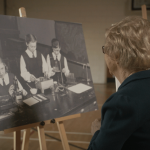The genesis of the Oscar-nominated film Sugarcane is located in the story surrounding the Tk’emlúps te Secwépemc First Nation when it announced the discovery of the remains of 215 children at the former Kamloops Indian Residential School in British Columbia.
A May 2021 New York Times bombshell story alerted director Emily Kassie to the story that engulfed Canada’s media for most of the rest of 2021, and as shown by the Times coverage, media across North America and beyond.
In an interview about the film on website Gold Derby, Kassie said that the Kamloops story was a turning point for her. She grew up in Canada but knew little about the residential school system, and despite her journalistic, globe-trotting work in conflict zones, she “had never turned the lens on my own country and the horrors it perpetrated against its first peoples.”
In response to her horror, Kassie has produced a horror film. Replete with the classic cinematic tropes of ominous music, shots of deteriorated Catholic statuary, and atmospheric pans of rundown houses and cars set against a majestic natural backdrop, Kassie and co-director Julian Brave NoiseCat have created a film in a genre one might call Indigenous Gothic. As in any old-fashioned gothic tale, the undisputed villains of the piece are the black-robed priests and black-habited sisters.
The film is much lauded. National Geographic acquired the distribution rights for Sugarcane, and it is currently a front-runner for an Oscar in the documentary feature category. Kassie and NoiseCat won Best Documentary Director at Sundance. Wendy Ide in The Guardian commended the film as a “measured telling” and “dogged investigation” of the Catholic Church’s abuse of Indigenous children. The New York Times reviewer calls it “must-see.”
But can what is documented actually be believed?
The film takes us nearly 300 kilometres to the northwest of Kamloops, to the Williams Lake First Nation, the site of St. Joseph’s Mission and Cariboo Residential School, which operated from 1891 to 1981. The Catholic Church, through the missionary priests of the Oblates of Mary Immaculate (OMI), administered the school until 1969.
Following the Kamloops announcement, and as First Nations across Canada vowed their own journeys of discovery of the still-to-be-found unmarked graves, Kassie quickly contacted Williams Lake Chief Willie Sellars with the idea of accompanying the community as it undertook its own investigation. Williams Lake First Nation received $8.6 million from the federal Residential Schools Missing Children Community Support program established in 2021.
In the Gold Derby interview, Kassie says, “It turned out the story really wasn’t about how many bodies there might be in the ground but what was going on within the school itself and what might have happened to babies who were born there.”

Julian Brave NoiseCat and his father Ed Archie NoiseCat look down at the Williams Lake Stampede from the top of “Indian Hill” on their roadtrip back to St. Joseph’s Mission, where Ed was born. (Emily Kassie/Sugarcane Film LLC)
The central plotline revolves around the artist father of co-director NoiseCat, Ed Archie NoiseCat. There is a mystery surrounding his connection to Williams Lake and the stories his family will and will not tell him about his birth. NoiseCat accompanies his father on a spiritual journey back to Williams Lake to discover the truth about his beginnings.
“We know that priests abused girls,” said Kassie. “Those girls gave birth to children, and some of those children were adopted out to white families and some of them were put in the school’s incinerator and that’s where Julian’s father was found.”
Kassie claims her film “breaks the news for the first time” of a “system of babies who were born at the school being put into the school’s incinerator.”
At the conclusion of the film, before the credits roll, viewers read two bald statements on the screen:
“The ongoing investigation at St. Joseph’s Mission has uncovered a pattern of infanticide” and “Ed Archie NoiseCat is the only known survivor of the school’s incinerator.”
But it turns out that this central plank of the plotline is, in fact, no mystery at all. As documented by Michelle Stirling in C2C Journal, there are many factual ellipses and errors in Sugarcane. The most egregious undermines the investigative integrity of the film.
NoiseCat’s father was not placed in the incinerator by either a priest or a nun but by his mother. This fact was not unearthed by dogged documentary filmmakers but was reported in the Williams Lake Tribune in 1959 after Antoinette Archie was sentenced to a year in prison for child abandonment. Who was the father? The man whom Antoinette would subsequently marry and with whom she would have seven more children, Ray Peters. Though Ed’s parentage is not in doubt, it is not revealed by the filmmakers.
The film allows the viewer to follow misplaced breadcrumbs so that even the reviewers can come to completely erroneous conclusions.
Peter Rainer of The Christian Science Monitor wrote, “The documentary’s furious emotional centre is the disclosure of Ed’s secretive birth at the St. Joseph’s Mission residential school, where he was subsequently abused, to a mother who was raped by a priest.”

Yet Ed never attended residential school, let alone St. Joseph’s, and was not fathered by a priest. If Antoinette had ever been raped, by a priest or another, there is nothing to indicate it was part of Ed’s story.
Rainer is correct when he speaks of a “furious emotional centre” at the heart of the film. But it is the deep grief of adults who were fatherless and motherless children, tenderly articulated by NoiseCat when he confronts his father.
In a tense conversation on the porch of an Airbnb overlooking a B.C. lake, NoiseCat describes how he used to watch the taillights of his father’s car disappear into the distance. Every time his father drove away, he would stare at those lights until he couldn’t see them any longer.
He tells him, “You don’t fully recognize the thing that we share. Your story is someone who was abandoned, but who also abandoned.”
Ed begins to cry, but they seem to be tears of self-pity.
“You’re looking for some kind of acknowledgement from me?” he asks.
In 2020, the Squamish Lil’wat Cultural Centre showcased an exhibition of Ed NoiseCat’s artwork. His son wrote an essay for Canada’s National Observer that treated his father’s artistic evolution. He didn’t hold back on the disordered familial relations.
“Dad divorced my mom because he loved alcohol more.”
“When Native Peoples magazine wrote a profile of him, it didn’t say a word about his kids or his family.”
“I had to lend him money to come to my high school graduation.”
It is significant that the title Ed gave his 2020 exhibit was Sqātsza7 Tmicw — Fatherland.
There is pity left for Ed, which his son clearly feels. Ed was raised by his paternal grandparents. His mother, Antoinette, who receives an unannounced cameo in Sugarcane, refuses to address the past, even if it means leaving her son in the dark. On a trip to a paternal aunt, Ed is asked, “Your mum won’t share?”
There are missing facts in the Sugarcane storyline that, by any fair evaluation, should exclude it from serious consideration as a documentary film, which are, after all, supposed to be treatments of verifiable facts. But there is also a missed opportunity, because an honest examination of the role the Catholic Church played in this tragic story is needed. Perhaps next time without the scary music and black-cloaked villains.
Canadian Catholic News



